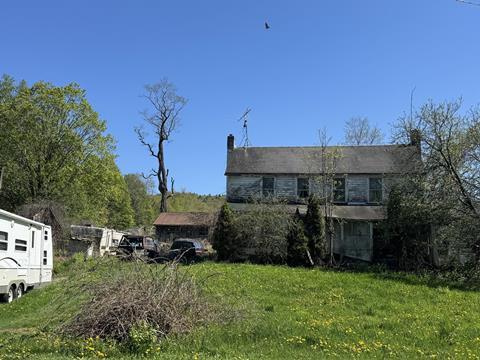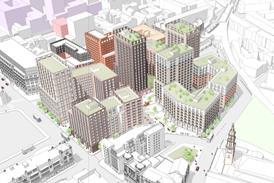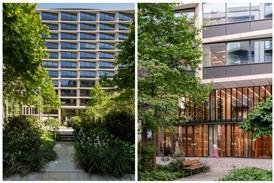Chris Fogarty argues that Britain’s planning system, however frustrating, has helped prevent the rural decline visible across much of the United States

I grew up in a rather grim seaside town in Devon surrounded by some of the most spectacular countryside and coastline in Britain. Whenever I return from New York, I’m struck by how little this landscape has changed: new housing estates may have crept up the valley and a Morrisons now sits on the old industrial estate, but Dartmoor looms in the distance, set amid farmland and woods that have barely altered for centuries. England’s “green and pleasant land” endures, deeply rooted in the national psyche.
Americans, too, see their remarkable landscapes as central to their identity. Their national and state parks are breathtaking, beautifully preserved and impressively managed. Yet outside those protected areas, much of rural America is incredibly visually depressing. Like many Brits, I once assumed rural poverty was confined to the Deep South, Alabama, West Virginia and the like, not something you’d find just 50 miles beyond Manhattan.
Venture outside New York’s affluent commuter belt and you begin to encounter a startling landscape: derelict houses, decaying town centres and overgrown and deserted lots. This rural blight afflicts vast areas of the country, helping fuel some of the resentment many rural Americans feel toward urban “elites”. It is a sentiment that twice helped carry Donald Trump to victory and which JD Vance captured so vividly in Hillbilly Elegy.
So why is the American countryside so different from the one we know in Britain?
The first reason is scale. US settlements began along the Atlantic seaboard and expanded deep into the continental interior in search of resources, timber and farmland at first, later coal, oil and steel. Each time an industry collapsed or shifted elsewhere, the towns that depended on it withered. Many residents left, but some remained, remote from other population centres and trapped in deepening poverty. The result has been not only the decay of small towns but the collapse of entire cities, Detroit being the most infamous example.
Living amid such neglect only reinforces the belief that government, at any level, neither cares about nor affects rural lives
Britain never experienced this pattern to the same extent. While many UK cities lost their industrial base and endured decades of decline, sustained reinvestment has allowed many of them to recover. The surrounding countryside, villages and market towns have always been only a close drive or train ride away and lived in by commuters and second-home owners who bring their wealth into those communities, often at the expense of local affordability.
The absence of planning controls in the US is equally striking. Beyond the suburbs, zoning is minimal. Rural roads are lined with a haphazard strip of small houses and outbuildings, almost all timber-framed and clad in wood or vinyl. Without constant upkeep they deteriorate rapidly, leaving an impression of neglect even when inhabited. Overgrown plots and abandoned structures reinforce the sense of decline.

Contrast that with Britain, where the green belt and national planning framework have preserved clear separations between town and country. To a British eye, the U.S. landscape can feel scattered and forgotten with little sense of cohesion or care.
Nothing symbolises this lack of investment better than America’s reliance on mobile homes. Almost 22 million people, around 7% of the population, live in them, overwhelmingly in rural areas. Typically costing a fifth of a conventional house, they come in three sizes: Single, Double and Triple Wide. Prefabricated and lightly constructed, they are particularly vulnerable to floods, tornadoes and wildfires. For a sense of scale, imagine one third of the UK’s population housed in caravan parks, exposed to the elements and visibly living on the edge of poverty.
When decay sets in, local authorities are ill-equipped to respond. Most rural counties are sparsely populated and generate little tax revenue. Even where planning rules exist, enforcement is weak. Add to this America’s deep cultural attachment to private landownership, and the result is a countryside where intervention is rare and blight accumulates.
Britain’s system may frustrate architects and developers, but it has protected its landscapes from the despair etched across so much of rural America
Living amid such neglect only reinforces the belief that government, at any level, neither cares about nor affects rural lives. Cities, at least, have access to resources or federal and state support. That divide helps partially explain why urban America tends to vote Democrat, while rural America remains deeply Republican, seeing little connection between their taxes and government action.
Some states have tried to respond. New York has adapted the concept of “land banks”, originally designed for urban renewal, to rural areas. Aided by the state, counties can pool resources to acquire abandoned properties, demolish derelict structures and, where possible, redevelop land for productive use. It is a start, but the scale of decline dwarfs these interventions.
Britain has its own rural challenges: shrinking services, ageing populations and limited job opportunities. Yet nothing approaches the wholesale abandonment of America’s rural districts, small towns and villages. The UK’s planning system, with its green belts, conservation areas and national oversight, has protected the countryside for all.
That battle over a new supermarket or housing estate being built in the countryside on the edge of a UK town may feel overly bureaucratic and reactionary, but it represents something vital: investment, planning oversight and political will. These interventions, however imperfect, keep rural communities cohesive and intact.
The American countryside shows us what happens when such mechanisms are absent. Vast regions have been hollowed out, leaving residents convinced they have been forgotten. Britain’s system may frustrate architects and developers, but it has protected its landscapes from the despair etched across so much of rural America.
Postscript
Chris Fogarty is co-founding principal of Fogarty Finger.
















No comments yet